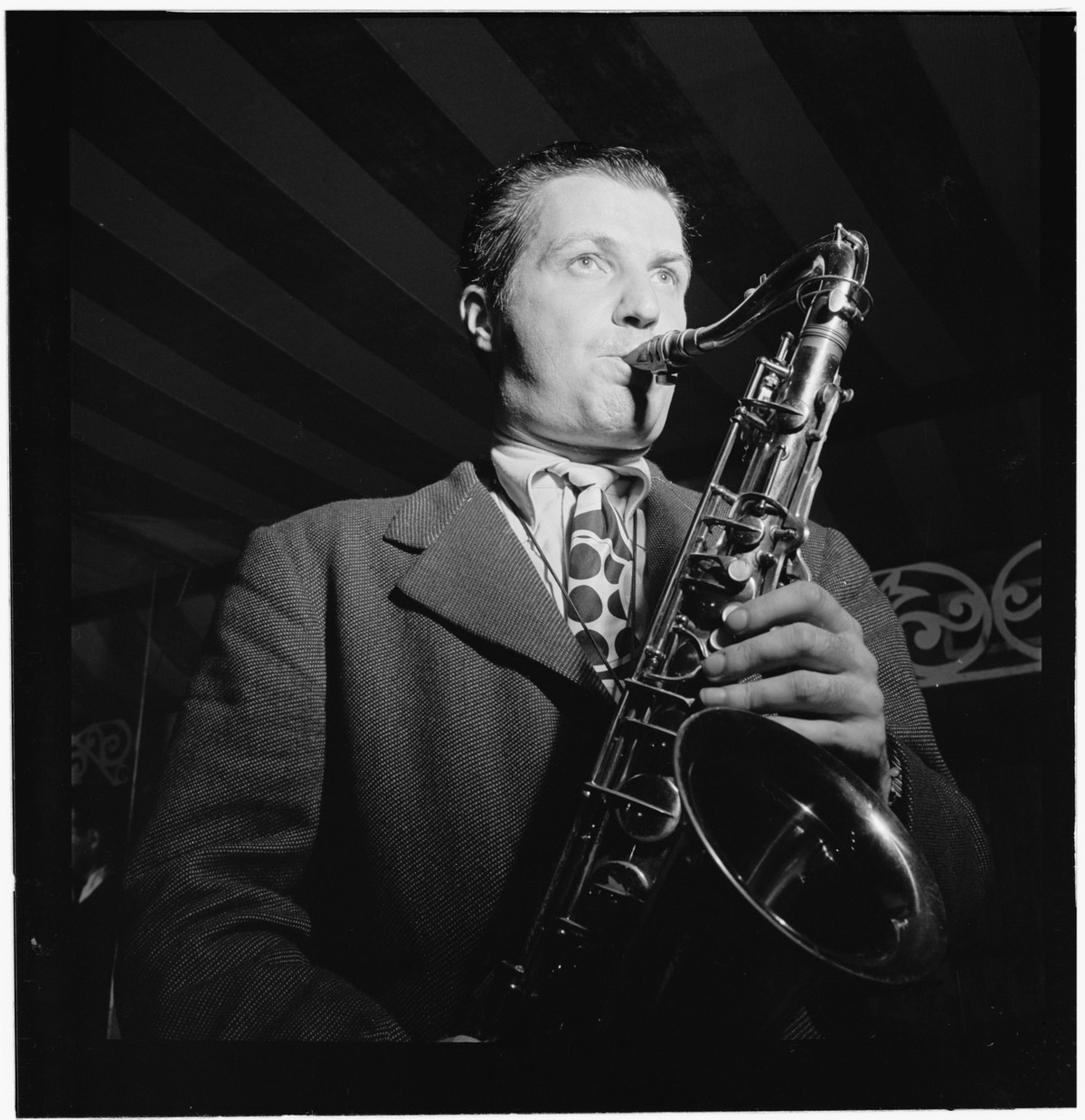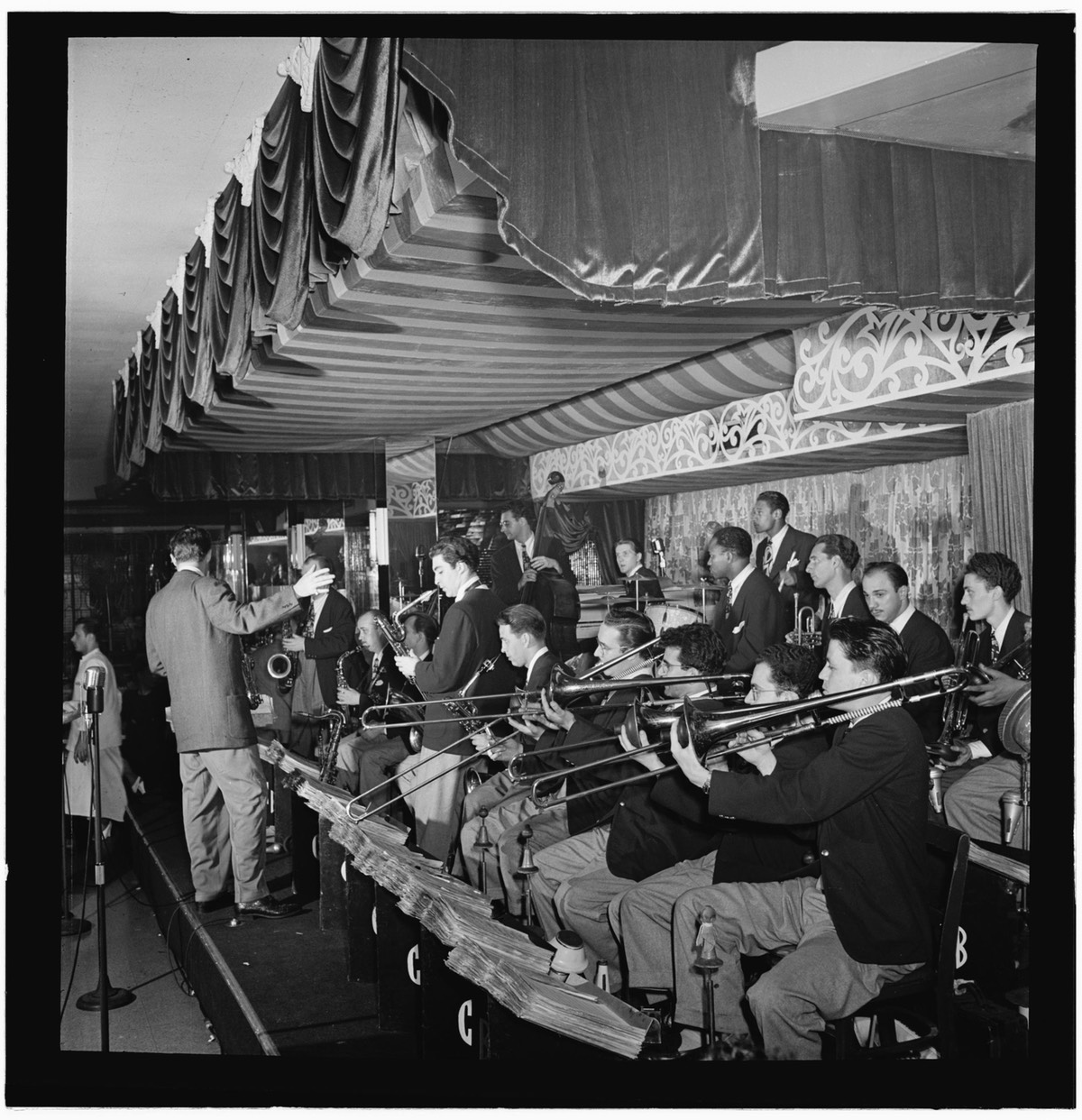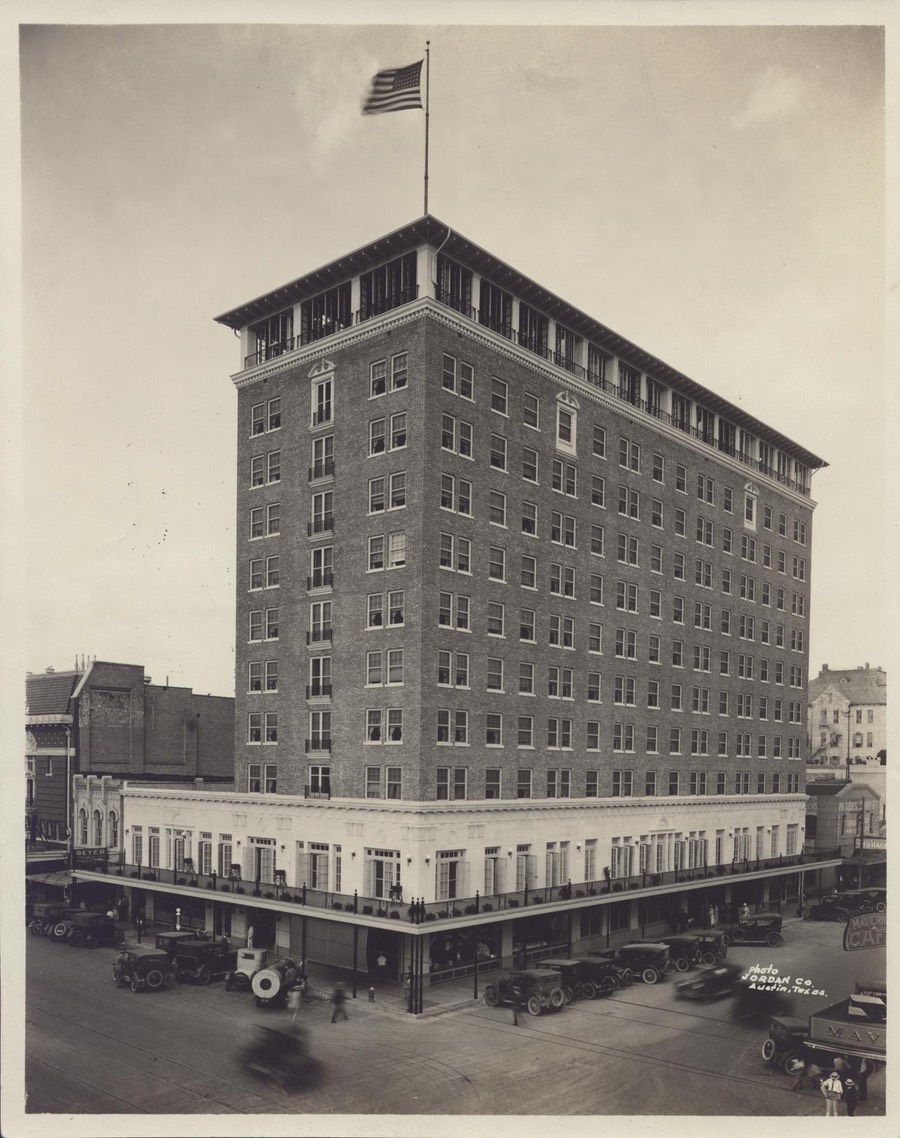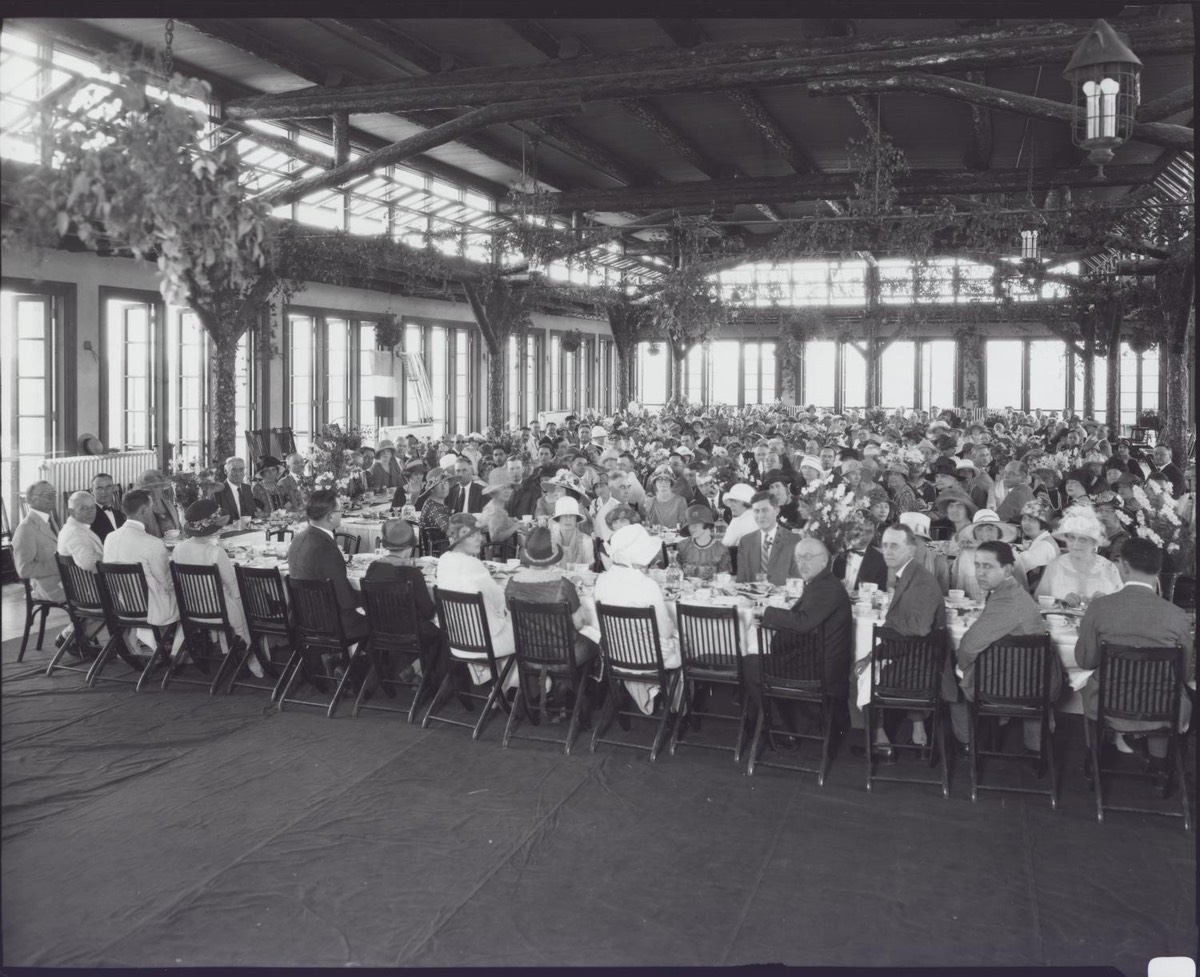
Charlie Barnet, 1946.
Gottlieb, William P. Portrait of Charlie Barnet, WOR broadcast, Aquarium, New York, N.Y., ca. Aug. United States, 1946. Monographic. Photograph. https://www.loc.gov/item/gottlieb.00461/.
There aren’t a large number of detailed first hand accounts of music in Austin in the 1920s or early 1930s. One exception is the invaluable memories of Gene Ramey, one of the most important bassists in jazz before 1950. We have analyzed his memories of Austin, his hometown, from his oral history with Stanley Dance for the Smithsonian in our exhibit ‘Athens on the Colorado: The Dominance of the Universities, 1929-1946’.
I came across another tableau of Austin in this period in the autobiography of Charlie Barnet, a saxophonist who led one of the most successful Swing bands of the late 1930s and 1940s. Barnet, who also recorded his story with Dance, discussed his time in Texas during the early 1930s in Those Swinging Years.1 Although curt, it is a valuable and rare impression of the music scene in Austin and Texas by a New York musician who experienced the crucial transition in jazz from the late 1920s into the Swing era.

A New York radio broadcast of Barnet and his orchestra, 1946.
Gottlieb, William P. Portrait of Charlie Barnet, WOR broadcast, Aquarium, New York, N.Y., ca. Aug. United States, 1946. Monographic. Photograph. https://www.loc.gov/item/gottlieb.00461/.
The grandson of a New York bank president, Barnet grew up in relatively privileged surroundings in the Northeast. Apparently always a lover of a good time, he made his way into the dance band scene around 1929. After hearing Louis Armstrong and then touring around Europe on an ocean liner, Barnet decided to go on a “southern adventure” in the early 1930s because so many of the musicians he admired had originated there. After packing up his Chevrolet convertible, he drove straight to Louisiana, where he tried to get work with the Flem Ferguson band at a hotel in Shreveport. While waiting for an opening for a saxophonist, he spent a few weeks in Kilgore near the Texas-Louisiana border. At the time, East Texas was in the middle of massive industrialization from the region’s early oil boom. According to Barnet, he found work playing in a “keg” house (“a dancehall with hostesses”) for roughnecks and wildcatters. These kinds of ad hoc venues covered the oil fields, he claimed, and sold cheap moonshine made from sugar (Prohibition was still current).
The place Barnet described in Kilgore was similar to venues that music historians often now call barrelhouses. Although not well documented, these quickly made entertainment spots in East Texas birthed some incredibly influential music. The most important style to emerge from the East Texas fields is now simply called barrelhouse piano. This form of African American blues piano—often characterized by a rolling two-beat bass line set against syncopated melodies in the right hand—influenced the boogie woogie style of the later 1930s and, ultimately, became a seedbed for rhythm and blues and rock and roll.
The group Barnet played with at the Kilgore “keg” house was pretty basic (the pianist could only play in one key) and the hours long (7 hour shifts without any break). Barnet mostly remembers the violence of the place. It didn’t take much for the audience to attack each other: the first fight typically began around 15 minutes after the band started. It was a fairly lawless scene, he remembered:
I got hit over the head in a brawl one night, and I still have the scar. I was talking when I should have been listening, and I was lucky I didn’t get killed, because life was very cheap in those oil fields. My mother never knew about the incident. I wound up in jail, one with a dirt floor and a bucket for a latrine. One of my fellow inmates set his beard on fire one day while in a drunken stupor, and another guy picked up the bucket to douse the fire....I had an offer from one fellow in jail with me to do away with the guy who had globbered me with the bottle. All he wanted for this service was a bus ticket to Omaha.
Luckily, Barnet got a place in the band in Shreveport soon after his incarceration. His time there was some of the happiest of his life, he said, largely because of the ready availability of marijuana and sex. A horrible experience with fairly pure heroin, supplied by a wealthy musician from Dallas, encouraged Barnet to depart Louisiana and, over the next year or so, he moved back and forth between New York, Shreveport, and Los Angeles.

Stephen F. Austin Hotel, 1924.
Jordan Company. Stephen F. Austin Hotel, photograph, 1924~; (https://texashistory.unt.edu/ark:/67531/metapth125167/: accessed September 27, 2022), University of North Texas Libraries, The Portal to Texas History, https://texashistory.unt.edu; crediting Austin History Center, Austin Public Library.
After gigging and jamming in L.A. with musicians like Lionel Hampton, Barnet got a call to come to Austin. Here’s how he described it:
I got a call from Ralph Spangler, who had remained in Ferguson’s band back in Shreveport. It seemed that Ferguson had turned the band over to Roy Riley, the drummer, and that band had then been fired, Spangler and some of the guys had joined Henry Schreiber’s band at the Stephen F. Austin Hotel in Austin, Texas, and they needed a tenor sax man. I left my car in L.A. and took the train to Austin. On arrival, I found we were all living in one big room, an unused banquet room, and that we played in the lobby of the hotel at noon every day and on Saturdays in the ballroom on the roof. We got twenty-five dollars a week besides our accommodations in the banquet room.
It was a weird scene. The people would sit around the lobby and stare at us as we played, and the Saturday night dances were poorly attended. The one bright spot, however, was that one of the elevator girls was very accommodating and would stop the cars between floors. She was pretty good-looking, too, and she had an auto she let me use.
Barnet’s description of Austin is brief, but it does give us some interesting information about the pop music scene in Central Texas during the early 1930s. The Stephen F. Austin was one of the most prestigious gigs in town at the time. Across the US, hotels provided some of the most consistent and best-paid employment during the 1930s. From what Barnet indicates, touring bands at the time could get longer-term work and were both paid and given a place to stay (even if it was not the most comfortable space). It also indicates one of the Jim Crow privileges and advantages that white bands had, since African American bands would not have been allowed to stay at the hotel.
It’s not clear how long the Schreiber band played, but it seems like it was at least a week. Barnet’s account tells us that music at the Stephen F. Austin played different roles at different times during the week. The hotel could have live music daily, although it seems it was likely a backdrop attraction for the hotel, a sign of elegance and sophistication, since it happened at noon. Dances where the music took center stage often occurred weekly during prime time on Saturday nights. So music at the hotel was more often a decoration than an event in itself.

The rooftop terrace of the Stephen F. Austin Hotel, where the Schreiber band would have played their unattended Saturday night dance(s).
Rooftop Terrace of the Stephen F. Austin Hotel], photograph, May 31, 1924; (https://texashistory.unt.edu/ark:/67531/metapth125272/: accessed September 27, 2022), University of North Texas Libraries, The Portal to Texas History, https://texashistory.unt.edu; crediting Austin History Center, Austin Public Library.
Barnet’s description of Austin as a “weird scene” is quite striking. Barnet had been travelling and playing in Texas, Louisiana, and California for the last year at least, so he had plenty of experience performing in a variety of places and venues, from other hotels outside New York up to the extreme he found amongst oil workers in Kilgore. His reaction likely didn’t stem from simply being in an unfamiliar place. The weirdness of Austin seems to have been rooted in its aloofness, its strange or apathetic reactions to their music. Barnet doesn’t add much to the observation, but his language suggests that he thought Austinites were so uninterested or inexperienced with modern popular music and jazz orchestras that they stared in disbelief and/or just didn’t show up for their dances.
This is itself quite strange and needs some interrogation. We know that Austin, in fact, had had quite a lively dance orchestra and jazz scene since the 1920s. Austin students were very attracted to contemporary dance music, provided a constant audience for it, and were the source for many of the musicians in local bands. For example, the Fred Gardner Troubadours and the Steve Gardner Hokum Kings often played weekly dances at hotels in Austin in the early 1930s, so Schreiber band’s engagement was far from unusual. Austinites were no strangers to the most progressive African American music from New York either—Duke Ellington performed on campus and Cab Calloway played at the Paramount Theater in 1933.
So, one way of reading Barnet’s comments—that no one in Austin knew about jazz or hip contemporary jazz—doesn’t make sense. There are other interpretations of his snide observations, however, that might prove more illuminating.
Austin was a small city at this point, just a little more than 50,000 in 1930. Having played plenty of gigs in East Texas, West Louisiana, and (later) in Waco just north of Austin, Barnet may have assumed that any time he played, there would be an audience. He may have supposed that modern dance music was so popular—and the opportunities to hear music during the Depression infrequent enough—that it would draw listeners and dancers no matter what, even in places populated by rural Texas oil workers. The fact that they had few avid listeners, despite being in one of the most prominent venues in a state capital, seemed to have astounded him.
Since we know Austin had a large and enthusiastic audience at this point and lots of bands and dances, we can re-interpret Barnet’s experience: it wasn’t that Austinites were un-hip or unknowing, but simply chose not to come hear his band. The truth may have been the opposite of Barnet’s reading. Austin may have had too rich a popular music environment to have any time for a recently put together no-name band with a cast of pick-up performers. The choice to not show up to any of their dances may be revealing evidence of the depth of the music scene in Austin in the 1930s, not its absence. Students may have their choice of bands and dance nights that week and demonstrated commitment to the musicians in their own scene. What may have been strange to Barnet was that a small town would 1) have that many other options; and 2) show such discernment.
I think the fact that Austin stuck out from the rest of Texas (and perhaps the rest of the country) to Barnet should still be noted and taken seriously. It may be that the “weirdness” of Austin music in the early 1930s was that a small town outside the coasts had such discerning audience and a large and vibrant music scene. Barnet just didn’t know what to do with this sort of place.
After striking out in Austin, Barnet and the Schreiber band moved 100 north to Waco for a one-nighter. Their gig, Barnet claimed, “turned out to be a pistol, too, a bad experience.” Their hotel performance was segregated, but in the way it happened in Austin at the Cotton Club and other places in Texas—by dividing the dance floor and audience with a rope. The Schreiber band played 4 hours for a white audience, took a half hour break, then played four hours for a black audience. It was apparently a hot evening and, to make matters worse, the band was drinking rubbing alcohol mixed with Coca-Cola.
Broke and out-of-work after their Waco gig, Barnet and Spangler called Riley in Shreveport and found they could play with him again. Before heading out, they made some DIY joints. Barnet’s account is both amusing and points to easy work arounds during the early period of cannabis regulation and criminalization:
We set out to find a drugstore where we could buy some cannabis indica. This was a liquid preparation for removing corns from the feet. You burned off the alcohol in the fluid and then dipped ordinary cigarettes in it. After the cigarettes dried, you had the equivalent of a bomb of marijuana stick. We scored at the first drugstore and then proceeded to get stoned.
They then hopped a train. After waiting amongst other down and out train riders in the yard, the high musicians caught a freight in the right direction after Spangler fell trying to run alongside the car. It seems they had a proto-Beat trip of near arrests and derelict sages: “We had other problems on the train from railroad detectives and local sheriffs chasing us, but there were some interesting characters with some deep philosophy riding the rails.”
Reflecting back, Barnet opined that “the reason [he] spent so much time in the South was that [he] had been impressed by stories and contacts with southern musicians, but unfortunately [he] found that most of those who could really play had gone north. Those who were left were not very good, with the exception of Peck Kelley, the piano player. For some reason he would never leave Texas.”
Again, Barnet shouldn’t be taken at his word, although this may have been true in his experience. At the time, plenty of remarkable musicians were still in Texas, although they were likely in cities and communities that Barnet chose not to visit. Dallas, for example, was a hub for African American musicians in the Southwest territory band circuit who would soon redefine jazz and provide a foundation for the Swing movement. In just a few years, musicians across the country would consider the Don Albert orchestra in San Antonio to be one of the best bands in the US, even if they never received an equivalent level of commercial success.
Barnet’s comments may have been simply self-serving. It was to his advantage to portray jazz history as a passing of the baton from musicians in New Orleans/the South in the teens and twenties to musicians in New York in the 1930s. It should also be said that, judging from his narration, Barnet considered the South (including his comments about the Austin elevator attendant) as a place defined by opportunities for his own sexual adventurism.
And yet, Barnet’s stories not only give us another angle on Austin’s uniqueness in the interwar period, but also paints Depression-era Texas as a place comprised by very different kinds of audiences and dance music scenes. Kilgore’s rough-and-tumble rural proletarian work was quite different from the elite and discerning milieu of small city Austin hotels. Their Waco all nighter, on the other hand, highlighted the state’s rampant Jim Crow segregation, but also indicates that, in some places, white bands played for all black audiences (not simply the other way around) in the town’s main hotel (black listeners and dancers were not allowed at performances in New York City hotels and in most of its night clubs, for example).
In the end, Austin takes up less than a page in Barnet’s memoir. The city’s oddness stood out enough, however, that his brief stay stuck with him for the next fifty years. Despite their brevity and somewhat throw away nature, his memories provide some worthwhile information about the early history of jazz and pop music in the Texas capital.
- Charlie Barnet with Stanley Dance, *Those Swinging Years: The Jazz Autobiography of Charlie Barnet (Baton Rouge: Louisiana State University Press, 1984).↩